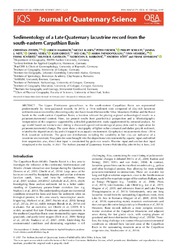Sedimentology of a Late Quaternary lacustrine record from the south‐eastern Carpathian Basin
Hambach, Ulrich
Klasen, Nicole
Obreht, Igor
Papadopoulou, Maria
Schäbitz, Frank
Gavrilov, Milivoj B.
MarkoviĆ, Slobodan B.
Vött, Andreas
Zeeden, Christian; Hambach, Ulrich; Klasen, Nicole; Fischer, Peter; Schulte, Philipp; Nett, Janina J.; Veres, Daniel; Obreht, Igor; Chu, Wei; Papadopoulou, Maria; Viehberg, Finn; Schäbitz, Frank; Gavrilov, Milivoj B.; MarkoviĆ, Slobodan B.; Vött, Andreas; Lehmkuhl, Frank, 2021: Sedimentology of a Late Quaternary lacustrine record from the south‐eastern Carpathian Basin. In: Journal of Quaternary Science: n/a - n/a, DOI: 10.23689/fidgeo-4329.
 |
Dokument öffnen: |
The Upper Pleistocene geoarchives in the south‐eastern Carpathian Basin are represented predominantly by loess–palaeosol records. In 2015, a 10 m sediment core composed of clay‐rich lacustrine sediments was recovered by vibracoring a dry lake basin located between the Vršac Mountains (Serbia) and the Banat Sands in the south‐eastern Carpathian Basin; a location relevant for placing regional archaeological results in a palaeoenvironmental context. Here, we present results from geoelectrical prospection and a lithostratigraphic interpretation of this sequence supported by a detailed granulometric study supplemented by ostracod analysis. An age model based on luminescence dating is discussed against sedimentological proxy data and its implication for palaeoenvironmental change. The cores show a stratigraphy of lighter ochre‐coloured and darker greyish sediment, related to the deposition of clay and silt trapped in an aquatic environment. Geophysical measurements show ~20 m thick lacustrine sediments. The grain‐size distributions including the variability in fine clay are indicative of a lacustrine environment. Fine particles were brought into the depositional environments by aquatic input and settled from suspension; also, direct dust input is constrained by grain‐size results. Riverine input and aeolian dust input interplayed at the locality.
Statistik:
ZugriffsstatistikSammlung:
- Geologie [933]
Schlagworte:
Carpathian BasinLate Quaternary
lacustrine sediment
geoelectric analyses
luminescence dating
grain‐size analysis
environmental dynamics
This is an open access article under the terms of the Creative Commons Attribution License, which permits use, distribution and reproduction in any medium, provided the original work is properly cited.

